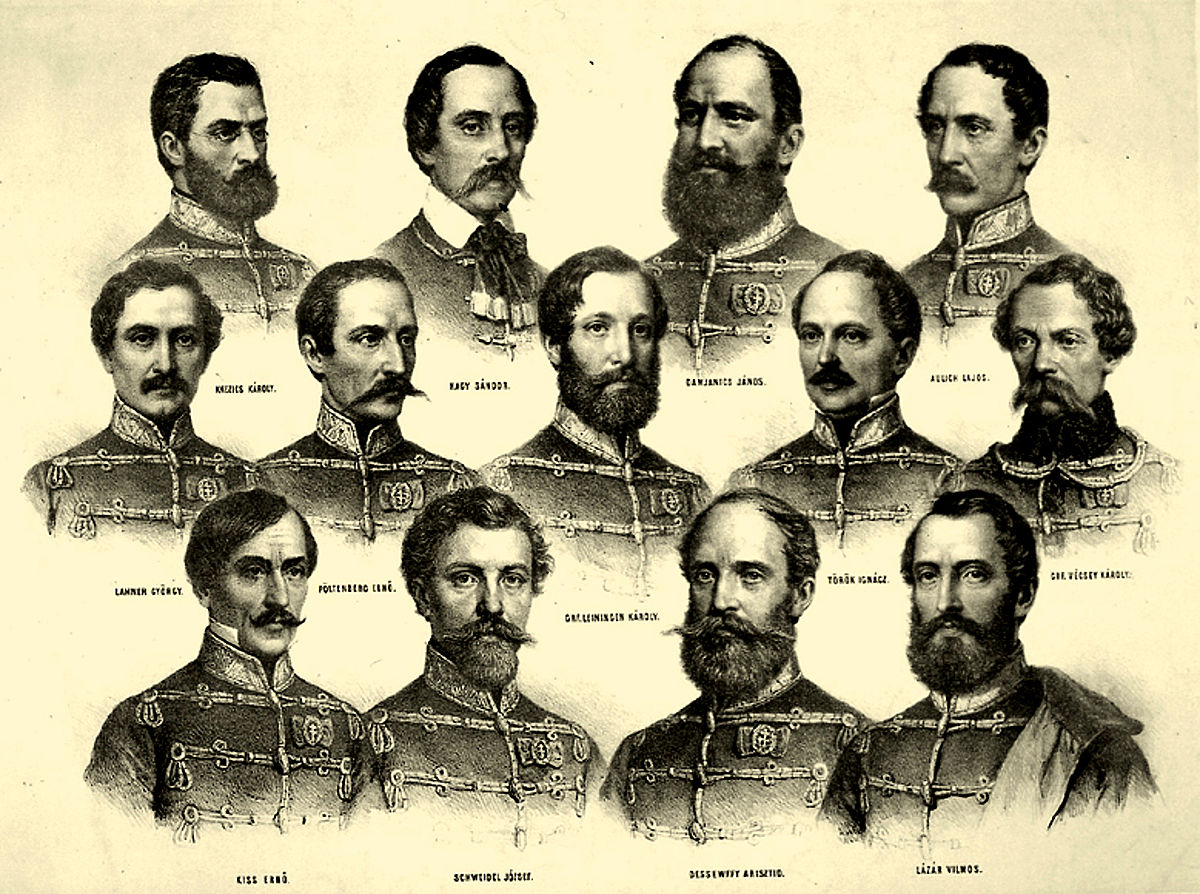13 martyrs or more? – facts you did not know about the tragedy of the Martyrs of Arad

6 October marks a sorrowful day in Hungarian history: one hundred and seventy-two years ago, in 1849, thirteen Hungarian military officers − twelve generals and one colonel – and Prime Minister Count Lajos Batthyány were brutally executed in Arad, which represented the height of the Habsburg reprisals that followed Hungary’s revolution and fight for independence.
Brief overview
The Hungarian Revolution of 1848−1849 is one of the most significant events in Hungarian history. This event is one of the bases of the national identity since it sought to achieve individual freedoms and establish national sovereignty. In May 1849, Emperor Franz Joseph called for Russian help, and the joint army of Russian and Austrian forces defeated the Hungarians.
The Hungarian Revolution ended on 13 August 1849 with the surrender at Világos, and it was followed by the Habsburg reprisal. Franz Joseph I. appointed Haynau, Field Marshal of the imperial army, to restore the order in Hungary. With the execution of the generals, Haynau wanted to set an example to the Hungarians and the world as to how rebels are to be dealt with and how to ensure order.
You can read more about the historical overview of the events in our previous article:
October 6 – The memorial day of the 13 martyrs of Arad
or watch this video about the Hungarian Revolution:
In the following sections, we have collected some lesser-known facts about the Martyrs of Arad.
Why 6 October?
The executions were not accidentally scheduled for 6 October. This day marks the first anniversary of the Vienna Uprising and the death of Theodor Baillet von Latour, Imperial Minister of War (he was killed when the seat of government in the ministry of war was stormed).
17 martyrs
Hungary is one of the few nations in Europe that can list 15−20 famous soldiers from a historical period, the names of whom are still remembered. All Hungarians can list the names of the Martyrs of Arad (and Pest) − Lajos Aulich, János Damjanich, Károly Knézich, György Lahner, Károly Leiningen-Westerburg, József Nagy-Sándor, Ernő Poeltenberg, Ignác Török, Károly Vécsey, Arisztid Dessewffy, Ernő Kiss, Vilmos Lázár, József Schweidel and Lajos Batthyány −, but the total number of people executed in Arad was 17.
Colonel Norbert Ormai (Auffenberg) was the first of the Martyrs of Arad.
In 1840, while serving as a lieutenant in the Imperial Army, he was accused of collaborating with Polish patriots from Galicia. He was arrested and spent seven years imprisoned. Ormai was a proponent of European democracy and liberal reforms; he was sentenced to another fourteen years in 1847, but he was pardoned in 1848. Ormai joined the Hungarian uprising within months and was commissioned to organise a rifle regiment. After Haynau arrested him, Ormai was hanged as a traitor on 22 August in Arad.
The fifteenth martyr was Lajos Kazinczy, the youngest son of Ferenc Kazinczy,
who was shot on 25 October in a rampart near the north-eastern gate of the Arad castle. Haynau probably separated his case from the thirteen officers executed on 6 October because Kazinczy only surrendered twelve days after the surrender at Világos.
Ludwig Hauk, the sixteenth martyr was hanged on 19 February 1850.
Hauk took part in the Vienna Uprising, and after the defeat in October, he fled to Hungary, where he became a military major in January 1849. He was arrested in Bihar in August, and he was already sentenced to 12 years in prison for his involvement in the Vienna Uprising. Hauk was sentenced to death in January 1849.
Although he was not executed, János Lenkey is considered the last martyr of Arad.
Lenkey was in Galicia when the news of the Pest Revolution of 1848 reached him, and he and his squadron fled home to apply for service in Hungary. Lenkey was also brought before a court-martial in Arad, but he went mad during his captivity, so Haynau decided to let him die in prison.
The Hungarian revolution of 1848 in the middle of a pandemic
Everything you need to know about the Soviet Monument on Budapest’s Freedom Square — PHOTOS
Not all the generals were of Hungarian nationality
As their names show, many of them had German – Aulich, Lahner or Leiningen-Westerburg −, Austrian − Poeltenberg − or Slavic roots – Damjanich and Knézich. Lajos Aulich, for example, was born in Pozsony (today Bratislava), had German origins and did not speak Hungarian. Ernő Kiss and Vilmos Lázár were of Armenian descent.
Last sentences
Lajos Batthyány was executed by firing squad in Pest on 6 October 1849, the same day as the 13 Martyrs of Arad. According to contemporary reports, he knelt in front of the firing squad and shouted the following before he was executed:
“Long live my country! Come on, huntsmen!”
“I’ve served and served, always served. I’m going to serve with my death as well. My beloved Hungarian nation and home, I know you understand this service,” said Lajos Aulich before he was hanged. Arisztrid Dessewffy’s last sentence was: “Yesterday heroes, today martyrs… This is what the service of my home commands”.
You can find the complete list of the last sentences of the 13 martyrs HERE.
Source: Daily News Hungary


Their sacrifice makes us proud and sad at the same time. Thank you and God bless you all.